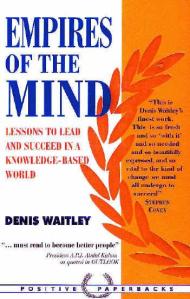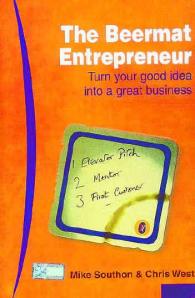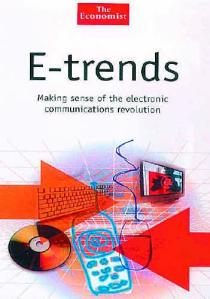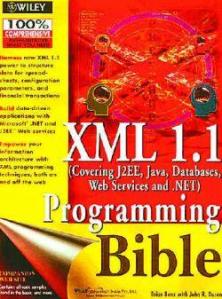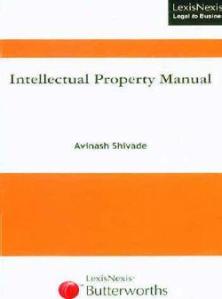Books2Byte – June 2004
- To lead and to succeed (June 07, 2004)
- From bytes to business (June 14, 2004)
- Network to bond (June 21, 2004)
- From India to America (June 28, 2004)
**
To lead and to succeed
D. Murali
| The competitive edge will belong not to those who use computers but to those who know how to inspire more productivity and excellence from each individual. More on becoming better people in a knowledge-based world. |
LESSONS to lead and succeed in a knowledge-based world are what Denis Waitley packs in Empires of the Mind, published by Positive Paperbacks (www.nbrealey-books.com) .
According to President A.P.J. Abdul Kalam, this is a `must read to become better people’, and Stephen Covey has rated the book as `so beautifully expressed’. “Consider the computer’s impact,” says Waitley.
“Designed as a tool for managing complexity, it also adds complexity, just as new freeways add more traffic.” How?
“The computer enables us to sort, store and retrieve material with ever-increasing speed. But the faster data can be analysed, the faster decisions can be expected.”
So? “Competitive edge will belong not to those who use computers but to those who know how to inspire more productivity and excellence from each individual.” Knowledge is portable because of advances in computing and telecom.
Ever tried `content analysis’? It is patterned after World War II intelligence-gathering methods, explains the author.
“Naisbitt Group researchers now scan 300 daily newspapers, clipping articles about local concerns. Together with the texts themselves, the number of column inches devoted to various issues helps predict basic trends.”
That digital convergence is making job disappear, in its traditional form, is a dreadful line. “Average size of the effective organisation is plummeting.”
And it is less of a hierarchy, and more like a web. What’s the difference?
“In a hierarchy, your title or position determines your power; in a web, it’s what and who you know… your relationships are crucial.” Don’t let Empires slip out of your hands.
Bar-coded below the eye
When Naomi Klein, author of No Logo remarks, `Brilliant and hilarious’ about Max Barry’s “Jennifer Government”, there is little option but to check it out. The novel, published by Abacus, is a political satire that is `caustically funny’. A key character is Hack. He sees two agents in an office, and “one of them had a weird smudge underneath her left eye, like a rectangular bruise. No: a tattoo, a barcode tattoo.” How bizarre, but that’s the one on the cover page. Then, there is Violet. “She powered on her laptop, snapped in an RJ45 connector. `Do you want to give me a login, or should I do it the hard way?'” Then comes `an ordinary employee password’ in Violet’s way. “`I can crack it if you want me to.’ … `I’ll ghost your machine. User is `applicant8,’ pass is the same.'” So there’s nothing holy about user name, after all! “Applications began streaming into Violet’s laptop, transforming it into a standardised, centrally managed ExxonMobil PC. While she waited, she glanced at the beige box humming behind her. It had the dimensions and aesthetics of a refrigerator: a Hewlett-Packard Unix machine. `This is your server here?'” Moral: Servers are accessible like fridges, not safe like safes. “Violet glanced at the hub, a squat, plastic box routing traffic between the server and PCs. Its green lights were flashing. `So my virus is getting transmitted to the server.’ `No, not your virus. Its signature. Big difference.'” Some misunderstanding, perhaps, because soon enough from each PC there is the chik-chik-chik sound. “`Disk activity.’ The machines crashed together. Each computer beeped simultaneously, rebooting.”
Many hundred pages after, again Violet, this time barging into a room: `Hi, I’m with I.T. I’m here about your computer.’ `The e-mail problem?'” It’s like trying a well-worn forecasting technique: “You want to do much more than you are now doing.” And the answer would be, `Yes.’ But Violet means business. “She pulled a disk out of her pocket and pushed it into the drive slot. `What’s that?’ `New drivers,’ Violet said. It was a 600,000-word dictionary, and it cracked Wendy’s password in about two seconds.” Faster than cracking open peanuts?
For Asians, logic is foreign
Distance is history, but we still think differently. Why? Richard E. Nisbett discusses the question in The Geography of Thought, published by Free Press (www.simonsays.com) . He delves into the `profound cognitive differences between Westerners and East Asians,’ a study that is essential if we have to coexist, working for one another. If you are working on computer languages, the chapter titled, `Is the world made up of nouns or verbs?’ may be of interest. Nisbett discusses objects vs relationships: “Categories are denoted by nouns.” It is easier to learn these, rather than verbs, he explains. Once learnt, “the label is then available for application to any other object having the set of properties.” Does that sound similar to a discussion of some object-oriented language? How is it that Easterners have relatively little interest in categories, asks the author. Orientals find it hard “to learn new categories by applying rules about properties,” perhaps because “ancient Chinese philosophers had little use for categories and were more interested in part-whole relationships and thematic resemblances than in category-member classifications.” Languages involve verbs too, and they’re about relationships. “Learning the meaning of a transitive verb normally involves noticing two objects and some kind of action that connects them in some way.” While the Westerners are more prone to seeing the world as made of “static objects” that can be grouped into categories, their Eastern counterparts see the world “much more in terms of relationships”. We pride ourselves on our computer skills but we have too little to showcase as world-class software. Are we good in slogging at data entry, but not so much at coding logic into programs? “Integrally related to the lack of interest in logic in the East has been a distrust of `decontextualisation’, that is, of considering the structure of an argument apart from its content, as well as a distaste for making inferences on the basis of underlying abstract propositions alone.” A book that can reveal to you the secrets of the complex software that keeps working silently in our heads; but be ready for some rude shocks to what you have always thought to be right.
(Books courtesy: Fountainhead fhbooks@satyam.net.in)
Tailpiece
Cop: “You were driving on the wrong side of the road!”
Motorist: “Oh, I work in a call centre, you see.”
Monday, Jun 07, 2004
http://www.thehindubusinessline.in/ew/2004/06/07/stories/2004060700120200.htm
**
From bytes to business
D. Murali
| It’s time to take stock of how technology has taken over our lives, and then move on to how you can make a good idea become a great business. |
CULTURE and politics in the age of cybertechnology is the focus of Pramod K. Nayar in Virtual Worlds, published by Sage (www.indiasage.com) — a book that is not about any software, circuitry and such, but on how bits and bytes are biting into our lives. “Networked and wired, jacked-in and cyborged… the rhetoric erupting from the new techno-scientific reservoir inundates descriptions of contemporary culture and the popular imagination,” he begins in chapter 1, and if that’s getting heavy, try this: “From online shopping to e-governance to electronic voting, we perceive an increasing `technologisation’ of the quotidian.”
Microsoft Word is redlining and suggesting `cabbaged’ for cyborged and drawing blank on certain other words, but Nayar is an English prof and so you can pardon yourself for a weaker vocabulary. `Tehne,’ is the root of the word technology, he would explain.
“Originally, it meant any skill or craft, and described a range of activities from engineering to the arts… Slowly, it split along two lines: one, the technical or technological, and two, the arts.” For Nayar, `bit’ or `code’ is an example of minimalisation and complexity, plus autonomy too. “Technoculture exhibits a certain mutational aspect,” he adds, and you may check if your mouse has turned into a cat.
On individual identity in cyberspace, the author would take you to a different level of discussion: “Identity fluidity contributes to anti-hierarchic nature of cyberspace… Women masquerading as men online, for instance, seek to neutralise gender-based discrimination.”
A good fun read, as long as you don’t question lines such as: “The challenge then for a cyberfeminist ethics is to develop further the argument that shows how the masculine individualism of traditional ethics is damaging in extreme circumstances, particularly when coupled with the dystopian, apolitical stance of cyberculture that allows individuals somehow to justify to themselves that their activities are not wrong.”
Reports de rigueur
ANNETTE Harper, OCP, ACE, MCNE, provides essential skills for database professionals in Crystal Reports 9 on Oracle, published by Tata McGraw-Hill (www.tatamcgrawhill.com) . The book has inputs on “one of the most powerful data analysis tools to draw information from Oracle databases, query and rank data, consolidate results, and develop integrated, interactive reports.” Crystal is a report-writing tool and the author does not delve into basics beyond that, because `a moderate level of expertise with Crystal Reports 9′ is presumed.
In the intro, she talks about the gulf between report writers and database developers: “This distinction is artificial. As a report developer, you are writing queries against the database just as any database developer would. You might even be creating views and stored procedures.” In a chapter on optimising, Harper discusses selection formulas that are equivalent to Where clause in a Select query. “Crystal Reports converts some operators and functions to their Oracle equivalent when they are used in selection formulas, but it does not convert all, or even most, operators and functions.”
However, if you wanted to use native Oracle functionality rather than Crystal Reports formula, your speed can be affected. Whole chapters are devoted to Crystal Repository, more tips, PL/SQL and so on. Useful appendices tackle errors and problems, as also functions and nuances. Add to your read-ware library.
YOUR ideas flowed when the only writing material you had was toilet paper.
Again, they bubbled when sharing a drink and so you scribbled on beermats. Okay, how do you proceed from there? For an answer on how to turn your good idea into a great business, here are Mike Southon and Chris West with The Beermat Entrepreneur, published by Pearson Education (www.yourmomentum.com) .
“This is not another book on theory,” Charles Dunstone writes in his Foreword. “It is based on authors’ real life experiences at the sharp end.” If you love success, this is a must-read, but remember that success in business involves hard work.
“Lots of it, twenty-hours-a-day-for-five-years hard work.” The authors write in their intro: “The air is still clearing from the great dotcom collapse. Incredible amounts of money have been lost — because people have gone about founding businesses the wrong way.”
The highway to hell, or the dotcom model of business development, involves the following steps: Get someone to come up with a clever-sounding idea; get some MBAs to invent a scenario whereby this idea makes pots of money; get a VC to throw millions of dollars at it; headhunt any skills you suddenly find you need (sales, accountants and so on); and get the hell out as quickly as possible, via an IPO.
If you want to succeed as an entrepreneur, check if you are free from a weakness: The inability to complete things. This is part of a bigger weakness, the book would advise, and that is lack of focus. “Focus on detail. More important, listen to your closest colleagues when they focus on detail.
Also check if you have cornerstones, that is, your associates. “Cornerstones are professionals, at sales, accounts or management, or they are experts in the relevant technology. Their solidity comes from their commercial or technical discipline.” What you need in a cornerstone is lots of SPPHCD: That is, solidity, passion, personal skills, hard work, courage and doers. “What you need is not ideas but good ideas, ones that really will grow into thriving businesses.”
There is no need to instigate a total, radical change; simply keep a sharp eye for how things are going, advise the authors. Lookout for `dislocations’: “Text messaging is the latest idea suddenly to catch on. Experts in the telecom business said it would replace pagers, which it has yet to do. They did not predict it would change the way teenagers communicate, which it has done.”
One of the worthwhile poster-able thoughts is this: “Business has already ceased to be about spreadsheets and software, and has entered the world of personal judgment and emotions.” Time to get up from barstools and put your ideas to action.
Tailpiece
“I have so many remotes that I’m looking for just one more… ”
“To add to your woes?”
“No, to remotely operate the other remotes.”
Monday, Jun 14, 2004
http://www.thehindubusinessline.in/ew/2004/06/14/stories/2004061400130200.htm
**
Network to bond
D. Murali
| Like it or not, we are all connected more closely than we think. Common principles underlie networks, be they electrical, computer, social or economic. Catch up on the science of a connected age. |
LIKE it or not, we are all connected more closely than we think. Our social networks are `tightly bonded’, Duncan J. Watts would say in his book on `the science of a connected age’, “Six Degrees“, published by Vintage (www.randomhouse.co.uk/vintage) . His range of study includes the Dutch tulip mania of the 17th century, success of Harry Potter, impact of September 11, structure of the Web and so on.
Common principles underlie networks, be they electrical, computer, social or economic, and by that reasoning if you know one, you know all. Unlike the physics of subatomic particles, the science of networks is “the science of the real world – the world of people, friendships, rumours, disease, fads, firms, and financial crises,” writes the author in his preface. In a chapter titled, `small worlds’, the book has a statistic from the Internet Movie Database: that between 1898 and 2000, roughly half a million people have acted in over 200,000 feature films. That “every actor could be connected to every other actor in an average of less than four steps,” is among the findings after the author’s team worked on raw data sourced from `Oracle of Kevin Bacon’. Clustering coefficient was found to be `much greater’ when the subject matter of study was power grid.
Networks come under threat from viruses. Both computer and human viruses perform `broadcast search’, says Watts. “Broadcast searches represent the most efficient way of starting from any given node and finding every other one by systematically branching out from each newly connected node to each of its unexplored neighbours.” Unfortunately, computers are more vulnerable than humans because the latter possess immune systems. A suggestion for Microsoft to protect customers is “to switch from a single integrated product line to several different products that are developed separately and that are designed not to be entirely compatible.” How does Google, the other big name in IT, manage processing demands? “Adding almost thirty servers a day just to keep up with the demand”, and that was a few years ago. A book worth networking with.
DNA computers and protein switches
IF you’re a librarian who doesn’t cross-reference information technology literature with biotech and vice versa, your boss could soon be looking for a replacement. “Biotechnology is one of the fastest growing, and most controversial areas of science and technology in the 21st century,” notes the back-cover of “Biotechnology from A to Z,” by William Bains, published by Oxford (www.oup.com) .
About the book, New Scientist had noted: “Any dictionary that lists the phrase `yuk factor’ has to be worth buying.” That is the last but one entry in Bains’s collection, described as `a flippant term for the very real observation that the public, and indeed many scientists, judge the ethical acceptability of experimental procedures and biological manipulations in accordance to a scale of personal distaste.’ Software may one day be rated on this factor, just as movies are given percentages. Zoonosis, that follows yuk is `infection of one animal by an organism that usually infects another species.’ While what infects rodents is also known to affect humans, there are no reports as yet of computer infections carrying on to people. CIP is cleaning-in-place, where one can sterilise and clean before each `run’ without dismantling the equipment; there should be no `dead legs’, that is pipes blocked at one end, or crevices where the cleaning liquid cannot flow. Remember this when scanning your disk, and include all files because you never know where dangers could lurk. The abbreviation cDNA looks like a close cousin of CDMA, but no, it is copy or complementary DNA. Cell culture is how we describe the current generation that flaunts a working or non-working mobile, but in the dictionary it means the cultivation of cells. `Laundering’ with money before it is about how black becomes white, but for biotechnologists, there is money in laundering; “enzymes are used to digest dirt from in-between cloth fibres.” Large amounts of experimental results produced by high-throughput, automated laboratories in genome projects have necessitated the use of LIMS, short for laboratory information management systems.
Okay, what are DNA computers? “This is the use of DNA as a computer. Information is coded in the DNA sequence, and processed by enzymes.” Slow compared to silicon, so hardware manufacturers need not panic as for now, but “DNA is best suited to a very long-term data storage.” How about trying proteins as switches? “Arrays of these have been assembled between electrodes and shown to carry out switching operations.” I’m yet to tell you about what Bains has written about Halobacterium halobium, a salt-loving bacterium with electrical and light-absorbing properties “as well as being able to self-assemble into membranes.” Something that could be the first step to a holographic computer memory system. Make place for this A to Z among your IT books.
Revenge of geography
GATHERING together some of the best pieces on the new economy, mobile telecom, software, entertainment and so on, here comes “E-trends” from The Economist. The first chapter, `untangling e-conomics’ warns of what can happen if governments choke the economic benefits of innovation: “Look back 600 years to China, which at that time was the most technologically advanced country in the world.” China’s progress went in reverse when “its rulers kept such tight control on the new technology that it could not spread.” Globalisation and IT were made for each other, another chapter would declare.
After e-commerce, get ready for e-government, beckons `the next revolution’; Singapore is the model that the `island site’ chapter speaks of, the GeBIZ gee-whizz. Learn about GovWorks, a US site that makes paying fine easier, online. A major beneficiary of the Net is pornography: “Plenty of the material on offer on many sites would never get an airing on television because it is too sexually explicit or politically incorrect.”
Even the best of software won’t work without organisational changes, observes `a touch of concrete’. While technology has made it possible to forget national boundaries, there is `the revenge of geography’ that comes last in the book, discussing the role of `location-based services’: “At the moment, Internet users navigate a largely placeless datasphere. But in future they will want location-specific information”. Punch line, therefore, is: “Distance is dying; but geography, it seems, is still alive and kicking.” Good read even if pulled out of history.
Books courtesy: Landmark (www.landmarkonthenet.com)
Tailpiece
“A robot has joined the teaching faculty.”
“To teach us what?”
“That would depend on what the class would program in his chip.”
Monday, Jun 21, 2004
http://www.thehindubusinessline.in/bline/ew/2004/06/21/stories/2004062100130200.htm
**
From India to America
D. Murali
| Catch up with the Suburban Sahibs this weekend – a story about the passage to the US of three immigrant families; their flair for programming languages; their quirks; and their sense of displaced identities. |
FOR those working with Extensible Markup Language, a good reference is XML 1.1 Programming Bible by Biran Benz and John R. Durant, published by Wiley Dreamtech India P Ltd (www.wileydreamtech.com) . The very first point on the cover could attract accountants too: “Harness new XML 1.1 power to structure data for spreadsheets, configuration parameters and financial transactions.” Let’s say you know HTML, but have you heard about “the granddaddy of all markup languages, Standard Generalised Markup Language (SGML)”? If you have seen XML documents, you would have noticed that they are tough on the eyes. Let that not put you off because XML is “not designed for us to read” but by XML parsers.
Okay, I thumb straight to chapter 13, on `creating an Excel spreadsheet from an XML data source’; this is something relevant if we are trying to consolidate data from different formats. “XML Flattener contains processing logic so that data in an XML file can be converted into a two-dimensional spreadsheet.”
Excel 2002 can do wonders, because it “figures out what should be represented as rows and what, as columns”; it even applies default formatting to bold and colour column headings. “Another way of importing XML into Excel is by using a special feature known as Web queries.”
The authors explain how, with a Web query, “you can import data from any page that is served up and parsed by the Web browser.” At the end of your work, you can make your Excel data portable by saving the same as XML spreadsheet. Let me try out a few X abbreviations on you: XACML is XML Access Control Markup Language; XI is XML integrator; and XDK is XML Developer’s Kit. If they are too boring, try X-KISS, XKMS, X-KRSSS, XML4J and XSL. You may like to retort with XSU for making me shut up the X stuff, but that means XML-SQL Utility. Essential read, because XML may be the ultimate link that holds our civilisation together, when things become too specialised and diverse.
Don’t trip over IP law
A heavy-duty book on law is what Avinash Shivade provides inIntellectual Property Manual, published by LexisNexis Butterworths India (www.lexisnexis.co.in) . Relevant, because if you are in any knowledge industry, such as software, IP should mean not only Internet Protocol, but also the subject matter of the book. “The intangibility of these rights leads to their own peculiar difficulties in creation and enforcement,” notes the author in his preface. “Not only in India, but all over the world, the legislatures are trying to grapple with the more and more complex fields of intellectual property rights like biotechnology, information technology, plant varieties, geographical indications and so on.”
Laws that we have are those that have evolved “in fits and starts, more in response to the onslaught of technology”. Contrary to popular misconception that IP rights can restrict use, Shivade points out how, in intellectual property rights, “the owner does not retain possession of any intellectual work”. How? “The very object is to make the work in which an intellectual property right subsists, available to as many users as possible.” Thus, the developer of computer software has to licence the software to users; a trademark has to be applied to goods, advertised and used.
“The four major intellectual property rights are copyrights, designs, patents and trademarks.” However, as a result of international conventions and agreement on Trade Related Intellectual Property Rights (TRIPs), there are new complex rights such as: “Geological indications, semiconductor integrated circuit layout-designs or `chips’, rights of plant breeders and protection of undisclosed information.”
The book devotes great attention to each of the four major IP laws: The Copyright Act, 1957; the Designs Act, 2000; the Trade Marks Act, 1999; and the Patents Act, 1970. In the Copyright Act, you would find the definition of `computer’ after `composer’; and, `computer programme’, as Sec 2 (ffc) defines, “means a set of instructions expressed in words, codes, schemes or in any other form, including a machine readable medium, capable of causing a computer to perform a particular task or achieve a particular result.”
Also, in what can make your English professor angry, `literary work’ includes computer programmes, table and compilations including computer databases, putting software on the same pedestal as Kalidas or Shakespeare. Accommodate Avinash’s Manual in your rack, pushing out outdated software manuals.
A to Z of desi in America
Who is an NRI? Answer: “The one carrying nostalgia in a suitcase.” This definition is from Amitava Kumar’s foreword toSuburban Sahibs, written by S. Mitra Kalita, and published by Penguin (www.penguinbooksindia.com) . He talks of `duty-free Indians’, `long-distance nationalism’, and how `roots have given way to routes.’
The book is about three immigrant families and their passage from India to America. Meet the H-1Bs of Kalita: “These were the newly arrived, highly skilled Indians who earned dollar salaries close to six figures, who were greeted by limousines at airports, who knew what Guess and Gap were, whose knowledge of programming languages from Java to COBOL to C++ had paved their entry to the US.”
ABCD is not new: American-Born Confused Desi; but can you stretch it to Z? “American-Born Confused Desi, Emigrated From Gujarat, Housed In Jersey, Keeping Lotsa Motels, Named Omkarnath Patel… ” And why did the CEO of Tata Consultancy change his memo headings from `Office Orders’ to `From the CEO’s desk’? Why is Mumbai having a rising DINK class: double income, no kids?
You may work across software platforms, but “ads tend to be caste-specific.” Also, “even flaws can be explained away.” For example: “37/5’7½” look much younger, good-looking Hindu Gujarati professional. Issueless innocent divorcee.
Working as Sr. Software Consultant, MS Computer Science. Easy going, down to earth, cosmopolitan outlook, good sense of humour, seeking attractive girl… ” Reserve the Sahibs for the weekend.
Tailpiece
“Suppose the short hand is in 4 and the long hand near 12. Means what?”
“Means you don’t have a digital watch on hand.”
Monday, Jun 28, 2004
http://www.thehindubusinessline.in/ew/2004/06/28/stories/2004062800100200.htm
**
